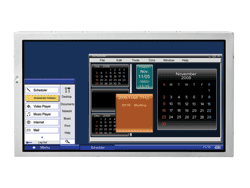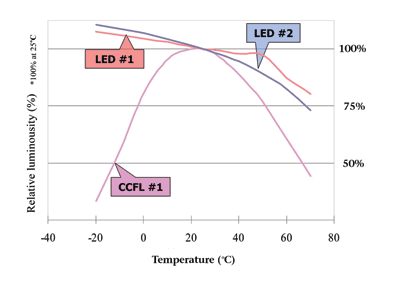Display backlighting: The quiet before the storm
Light-emitting diodes are about to sweep through the liquid-crystal display industry, blowing out cold-cathode fluorescents
BY ROBERT DUNHOUSE
NEC Electronics America
Santa Clara, CA
http://www.necel.com
There is a quiet storm building on the horizon in LCD backlighting: The incumbent backlighting technology, the cold-cathode fluorescent lamp (CCFL), is about to experience a force that’s blowing into town like a freight train: the upstart LED. While LED backlights are still just a drizzle for consumer products like LCD TVs, in the industrial LCD market, it’s a full-out downpour. For designers, it is important to understand what is driving the transition, the advantages and disadvantages, where we are today, and why it is so important to the industrial LCD market.

LED-backlit LCDs are massing for an onslaught.
The end of CCFL’s reign
For nearly two decades, CCFL lighting has been the predominant technology behind color flat panel LCDs. While improvements have been made over the years, CCFL technology has, for the most part, reached its maturity. In the near term, it will continue to be the most commonly used backlighting technology, as it provides a low-cost and proven solution. While LED technology has been around for many years, it has primarily been used for simple status indicators or simple numeric displays.
Things began to change when the European Union (EU) decided to go green. To help manage the sheer logistics of how to deal with the mounting levels of toxic chemicals commonly used in most electronic products, the EU established the Restriction of Hazardous Substances (RoHS) directive. Because mercury was one of the targeted substances for elimination under the directive, and CCFLs use mercury vapor to generate light, an alternative was desperately needed. Enter LEDs.
When white LEDs were initially used to light LCD displays, they surfaced mostly in smaller panels with a diagonal of less than 5 in. These were displays typically used in mobile applications such as cell phones. Their performance was limited and their lifetimes were very short.
The technology as it stood back then could realistically have LED lifetimes less than 7,000 hours. When compared to the more mature CCFL backlighting, which typically claimed over 50,000 hours, LEDs were at a distinct disadvantage. They were also inefficient and consumed more power in the form of heat, requiring thermal countermeasures for all but the smallest, simplest and low power designs. Still, they did bring certain advantages over CCFL solutions.
Today, LEDs not only fulfill the European green directives which have now spread to China, Japan and beyond they also have become smaller, more rugged, better performing in low ambient temperatures, and more efficient than CCFLs. As the world has embraced the reduction of hazardous substances, the focus has been on improving LED technology as rapidly as possible. The industrial market was first to capitalize on these performance advantages and is quickly implementing LEDs in displays larger than 5 in.
LED categories
LEDs generally fall into two categories — namely, low-profile, high-efficiency LEDs and long-life LEDs — and they are selected based on the end application. Low-profile, high-efficiency LEDs are typically used in mobile products that rely on batteries for power. Minimizing power is the obvious benefit, but because size matters a lot in these applications, keeping the backlight thin and light is mandatory. LED backlights can be up to approximately 40% thinner than CCFL solutions, and can also now achieve up to 50% higher power efficiencies, where lifetime figures are approaching 30,000 hours.
In addition to being more mechanically robust and not negatively affected in cold temperatures, LEDs promote handheld battery operation with their improved efficiency and easier drive methods, all of which makes them especially attractive to the industrial LCD market.
The circuitry to drive white LEDs is typically less complex, less costly, and does not use the high voltages required by CCFLs. The latter has always been considered a potential safety concern, especially when used in volatile environments, such as for gas pumps. It is not uncommon for most CCFL inverters to output startup voltages of up to 1,500 Vac while the drivers for LEDs are less than 100 Vdc. It is also common for many of the LED products on the market to run their LED backlights below 30 Vdc.
Long-life white LEDs are typically larger and less efficient, but offer higher peak-luminance capabilities, greater thermal tolerances, and significantly longer lifetimes up to 70,000 hours making them competitive with, if not superior to, CCFLs for use in devices with stringent lifetime and performance requirements. LEDs range from 50% less to 20% more efficient than CCFLs, depending upon the type selected.
LEDs really shine though when it comes to operating in extremely hot or cold temperatures. CCFL performance greatly decreases in extreme temperatures, especially cold, and continued use at these extremes will result in significant reduction of bulb life, whereas long-life LEDs do not exhibit this problem (see Fig. 1a ).
However, temperature brings out both good and bad characteristics for LEDs. White LEDs experience greater color temperature variances when exposed to ambient-temperature variations (see Fig. 1b ), which could be detrimental for in-field diagnostics where color information is critical for accurate analysis.


Fig. 1. While the luminance of LEDs is better than that of CCFLs over temperature (a), LEDs experience greater color variance (b).
Balance by color addition
For markets where the absolute highest color performance and stability are required, designers are turning toward alternative types of LED backlighting like red-green-blue (RGB) or tricolor LEDs. As with any high-end technology though, this comes at a price.
Over the years, RGB/tricolor backlighting has evolved, with the first generation using a single in-line string of separate red, green, and blue LEDs. Their output was projected through an outer light guide to a curved end reflector, which acted as a light mixer to combine the three primary colors into white, and finally through an inner light guide to develop the uniform light plane behind the LCD TFT glass assembly. While effective, it also generated a centralized heat source that required large heat sinks, in some cases the same size as the panel itself.
To address the heat issue, the second-generation designs split the single in-line LED string into two. Each LED string was then focused through its own backlight structure similar to the one just described. This reduced the temperature issue somewhat but still required heat sinking to manage it thermally. Cost was another disadvantage, as the backlight structure was very expensive to manufacture and the thickness of the LCD module was quite large.
Taking these factors into consideration, the current tricolor LED devices combine a separate RGB die into a single package. The primary colors are actually mixed within the device, so the user only sees white being projected from the LED package. This made it possible to create a matrix of tricolor LEDs that directly backlit the TFT LCD, eliminating the centralized heat source and the complex backlight assembly to achieve smaller, more cost-effective LCD modules.
Tricolor LEDs technology is important because of the advantages of superior color saturation and color stability over the life of the display that it brings to the table. Tricolor LED backlighting can achieve very high color saturation; panels with tricolor LED lighting are achieving more than 105% of the NTSC color standard, whereas high-performance CCFLs can only produce approximately 90%. The color reproduction of tricolor LEDs is stunning.
Tricolor LEDs also deliver the ability to maintain color stability throughout the display’s life. Color accuracy is crucial in the medical industry for proper diagnosis, and there are several established color temperature standards that both define a specific color temperature and require it be maintained over a certain lifetime. This is primarily aimed at very demanding medical applications like x-ray imaging, and ensures viewing consistency as doctors move from each reviewing station.
This is accomplished at the panel level through an optical device that provides feedback to the circuitry driving the tricolor LEDs. This circuitry independently varies the current drive of each primary color to maintain color temperature in real time. The drive relationships to the tricolor LEDs can be controlled in software, enabling the LCD manufacturer to produce only one product for a world market with varying color standards, rather than requiring multiple different products for each region. This could not be accomplished with CCFL products.
LEDs’ bright prospects
Many companies are modifying existing LCD products and exchanging their CCFL bulb assemblies with LEDs. However, to do this correctly, the color filters in the TFT LCD should be adjusted to match the spectral output of the LEDs. Many new LED backlit products from the panel manufacturers have already been optimized for LED operation. ■
Advertisement
Learn more about NEC Electronics America





